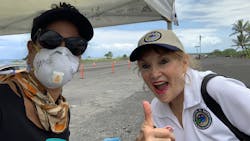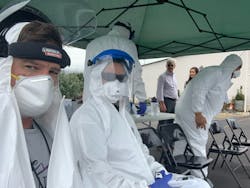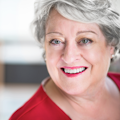The spirit of ohana: confronting COVID-19 island style
On January 1, 2020, most citizens in our country and around the world were excited about the New Year. Some were recovering from an overload of partying and others were making plans to better their lives.
Seventy-six days later, people throughout the planet began to hear about a novel virus moving from country to country. With every news change, the level of uncertainty escalated. Initially, many thought their lives would not be affected. While no one had the real answers, it quickly became clear that health-care providers would be involved in the battle against COVID-19 on many levels.
Servant hearts called into action
Dental professionals have servant hearts. We are hardwired to want to be part of the solution. Ohana, a beautiful Hawaiian word, means “family” in the most extended sense. Your ohana not only includes your entire biological family, but it also includes members of your whole community, whether it is personally or professionally. Being true to your ohana means nobody is left behind or forgotten. When Hawaii’s COVID-19 task force put out a call for volunteers to participate in a COVOD-19 screening in Kona on the Big Island of Hawaii, Laura Mallery-Sayre and her husband, Frank Sayre, volunteered immediately. They knew they needed to help their ohana.
Frank, a recently retired dentist, spent 50 years providing dental care to many island residents. Like dental hygienists everywhere, Laura’s office had closed, so she was free as well. In addition to their professional health-care credentials, the couple has established deep roots in their tight-knit community. Due to a deep personal loss 22 years ago, a foundation honoring their son had raised funds to support purchasing life-saving equipment used by local fire, EMS, and rescue groups throughout the island. Their organizational skills were well known, so it was a natural fit for the two to become involved in the screening efforts on the island.
Understanding the need on the Big Island
Here is their story. It is a story of giving back, recognizing a need, finding a niche, and utilizing their unique organizational, communication, and people skills.
Hawaii’s COVID-19 task force is headed up by Lt. Governor Josh Green, who is also a physician. The first drive-through COVID-19 screening efforts took place on March 15, 2020, in Kaneohe, Oahu. This pilot project was spearheaded by Scott Miscovich, MD, a senior advisor to Lt. Governor Green. Much was learned from that initial effort.
It was clear that the Big Island of Hawaii needed screening services as well. The wheels were put into motion immediately, and the task force on the Big Island reached out to Frank and Laura to support the first drive-through screening in Kona. The couple immediately contacted potential volunteers. They also worked with the media to inform community members and island visitors about the testing events. The COVID-19 task force’s goal was to provide testing to those who suspected they had been in contact with a COVID-19 carrier and islanders who routinely come in contact with large groups of people, many of whom work in the hospitality industry, as well as visitors and tourists.
Strategic planning
On Wednesday, March 18, 2020, the county of Hawaii closed all of the beaches on the island. The shutdown included a state recreation area known as the Old Kona Airport Beach Park, a well-loved park that parallels the rocky ocean front. The original mile-long runway still exists. It was long enough to ensure social distancing, so was deemed an ideal place to set up a pop-up mobile site. Task force organizers knew traffic control was critical. It was important to have safe triage measures as cars drove through various stages of the qualification process. The first two Kona screenings were scheduled to run from 8 AM to 3 PM on March 23 and March 28, 2020.
Volunteers from all over the island manned the event. Nonmedical volunteers and county workers were involved in the setup and teardown of the mobile site. The local Ironman association loaned portable tents to the task force, and local groups donated food for the volunteers. Health-care professionals such as Frank and Laura, along with physicians, registered nurses, physician assistants, and Hawaii Fire Department EMS specialists were involved in the testing phases that required a health-care background.
Implementing the plan
On the first day, Dr. Scott Miscovich reviewed the testing protocol with the volunteers. One of the biggest challenges was helping people understand who would receive the COVID-19 test. The volunteer health-care providers’ communication skills were put to an amazing test. Not everyone who wanted screening was eligible.
The screening/testing process had four stages. When the park gates opened at 8 AM on the first day, hundreds of cars were already lined up for a mile or so. Within the first hour, more than 500 cars had passed through the gates.
As cars entered the testing site, everyone was given information about the COVID-19 illness. All volunteers wore appropriate PPE for each stage of the screening. People were asked if they were symptomatic or not. This was the initial cut point. Those without clinical symptoms were instructed to return home and monitor for health changes.
Testing the eligible: Day 1
At the next station, applicants held their completed forms, personal identification, and insurance cards up to their car windows. Volunteers who were not health-care providers snapped photos of the completed documents, and information was uploaded to the cloud. Technology and ingenuity created a safe, secure information pathway for all.
Frank and Laura’s years of health-care experience proved invaluable. Along with the physicians, they performed the in-depth health screenings and provided copious amounts of information on disease pathways and appropriate infection control practices. They were able to give sound advice on how people could protect themselves and their families.
As cars approached the third station, the process sped up. The cars were now divided into three lanes. Hawaii Fire Department EMS team members, donned in full hazmat suits, took infrared temperatures, recorded blood pressure and pulse oxygen saturation readings, and reviewed the medical histories in depth. The final station, manned by registered nurses and physician assistants, again garbed in full PPE, performed the actual COVID-19 testing using nasal swab kits.
By the end of the first day, 1,629 people had shown up at the site for screening; 299 ended up being tested; and four were positive.
Five days later
Within the week of the first screening, word had gotten out that only symptomatic people were eligible for screening. Tourism is the main industry on the island and throughout the entire state. People at risk were now urged to get tested for a wide range of reasons, even if asymptomatic. The pool widened to include:
- Those who had recently arrived on the island from the mainland
- College students returning from spring break
- Those who had recently visited an international hotspot
- Frontline health-care workers
- Those who had direct public contact in places such as restaurants, grocery stores, retail, personal services such as beauty workers, etc.
- Workers who had direct tourist contact, such as in hotels, airlines, car rentals, tours
The information dissemination had a dramatic and positive impact on the numbers. Three hundred fifty people showed up on March 28, and 300 actually needed to be screened. This resulted in a much more effective use of time and resources. Of those tested, two were positive.
The testing results and the costs
The completed tests were sent off to labs in Honolulu and California. The COVID-19 test used in the project typically has a three or four day turnaround, but the labs were overloaded. It took up to 10 days for all results to be in. All participants were notified of their test results, and all positive results were sent to Hawaii’s State Health Department.
Testing was free for anyone deemed eligible. Hawaii’s COVID-19 task force covered the laboratory fees. The testing labs waived the copay for anyone who did not have health insurance.
Post screening
Laura and Frank disposed of their masks and gloves when they got back to their vehicle and used hand sanitizer prior to getting into their truck for the drive home. As soon as they got back to their house, they showered outside, and every shred of clothing was immediately washed in hot, soapy water. And they sprayed down their truck twice with a disinfectant.
But their work was not over with the screenings. A lot of worried people are calling them at home, but Laura looks at this as another opportunity for education and reassurance to the members of their ohana.
Final thoughts
After the second day, Dr. Miscovich reflected that the COVID-19 testing experience in Kona had been much smoother than previous screenings on other islands. Frank and Laura knew about 90% of those driving through for testing. Dr. Miscovich felt their reassuring presence expedited the entire process. No one was angry when Frank explained the test would likely show up negative if they did not have symptoms.
In response to Dr. Miscovich, Frank quipped, “I know how to handle people who have issues with trust. I’ve spent 50 years with a needle in one hand and a drill in the other.”
Laura’s reflection on their contributions: “It was very apparent that our support was valued. We are all in this together. It is going to take our entire health-care community to help end this situation and protect everyone.”
The community simply trusted two dental professionals who were serving their ohana.
Author’s note: The author wishes to thank Laura Ruminski of the West Hawai’i News for sharing her photographs of the Kona COVID-19 screening project.
Additional sources
- Doctor demonstrates how a sample is collected for COVID-19 testing. KITV. https://www.kitv.com/story/41878513/doctor-demonstrates-how-a-sample-is-collected-for-covid19-testing
- Hawaii test drives COVID-19 drive-thru screening program in Kaneohe. KITV. https://www.kitv.com/story/41897124/hawaii-test-drives-covid19-drivethru-screening-program-in-kaneohe.
- COVID-19 leads to state parks, facilities closures effective Wednesday. https://www.westhawaiitoday.com/2020/03/17/hawaii-news/covid-19-leads-to-state-parks-facilities-closures-effective-wednesday/
- Drive-through COVID-19 testing comes to Kona on Monday. West Hawaii Today. https://www.westhawaiitoday.com/2020/03/19/hawaii-news/drive-through-covid-19-testing-comes-to-kona-on-monday/
- Getting a better understanding: Second drive-through COVID-19 testing slated for Kona. West Hawaii Today. https://www.westhawaiitoday.com/2020/03/27/hawaii-news/getting-a-better-understanding-second-drive-through-covid-19-testing-slated-for-kona/
- Testing continues as virus case count rises. West Hawaii Today. https://www.westhawaiitoday.com/2020/03/29/hawaii-news/testing-continues-as-virus-case-count-rises/
About the Author
Anne Nugent Guignon, MPH, RDH, CSP
ANNE NUGENT GUIGNON, MPH, RDH, CSP, has received numerous accolades over four decades for mentoring, research, and guiding her profession. As an international speaker and prolific author, Guignon focuses is on the oral microbiome, erosion, hypersensitivity, salivary dysfunction, ergonomics, and employee law issues. She may be contacted at [email protected].





